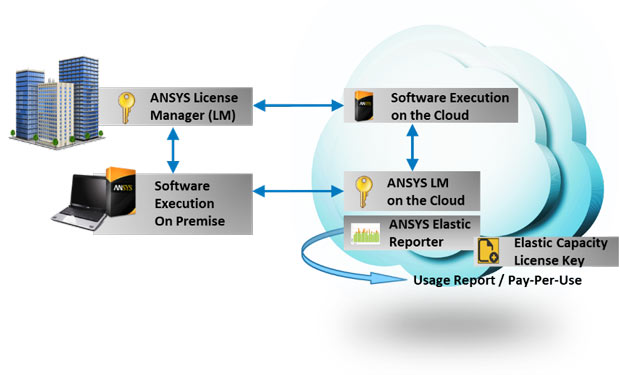Pay-Per-Use Licensing for Cloud Computing
Latest News
April 5, 2016
 Dear Desktop Engineering Reader:
Dear Desktop Engineering Reader:
Developing a software license strategy that puts you in a super position for all likely scenarios can seem like pondering Schrödinger’s cat. And cloud and hybrid cloud computing setups aren’t making it easier. Today’s Check it Out link goes to an upcoming webinar explaining a software licensing product that should provide ANSYS users and those considering ANSYS solutions a licensing model that adapts for dynamic simulation environments.
The “Pay-Per-Use Licensing for Cloud Computing” webinar will explain the new ANSYS Elastic Licensing pay-per-use model. Elastic Licensing provides hourly-based, “on tap” access to most ANSYS physics solutions, such as fluids, structures and multiphysics, in a single license called the ANSYS Elastic Unit.Elastic Licensing doesn’t replace the company’s traditional lease or paid-up license models. Rather, it allows you to size your paid-up or lease license pool to your typical workload and provides as needed access to the ANSYS portfolio for more users, during peak demands, to handle short-term projects or whatever.
It begins with a single license called the ANSYS Elastic Unit. It’s built around a defined amount of Elastic Units, which serve collectively as a time pool. You draw from this pool when you check out an ANSYS application, and each application consumes a set number of Elastic Units per hour. So, it’s like a Starbucks pre-paid coffee card for simulation.
The ANSYS Elastic Unit has a cloud component called the ANSYS Elastic Reporter. It provides you with visibility into your Elastic License usage, which should help you track usage and costs by departments and projects, answering a key concern of the beancounters.
Elastic Licensing should help cope with many knotty software licensing issues experienced by dynamic engineering companies and exacerbated by cloud and hybrid computing setups. For example. it appears to address concerns like optimizing license and hardware use, predicting what products you need to have licenses for and the like. Most of all, it should help keep development moving forward when you get slammed with a lot of work because you don’t have to hassle with an approval process with the bosses. You draw Elastic Units and keep working.
 The ANSYS Elastic Licensing model offers pay-for-use access to most of ANSYS’ portfolio of engineering simulation software including electromagnetics, fluids, structures and multiphysics. Image courtesy of ANSYS Inc.
The ANSYS Elastic Licensing model offers pay-for-use access to most of ANSYS’ portfolio of engineering simulation software including electromagnetics, fluids, structures and multiphysics. Image courtesy of ANSYS Inc.If a flexible software licensing strategy is your goal, ANSYS’ new Elastic Licensing model could be what you’re looking for. Click today’s Check it Out link to register for one of the live ANSYS webinars detailing the Elastic Licensing model on April 14 at 9 a.m. or 4 p.m. (EST) to learn more.
Thanks, Pal. – Lockwood
Anthony J. Lockwood
Editor at Large, Desktop Engineering
Register now for “Pay-Per-Use Licensing for Cloud Computing”.
Subscribe to our FREE magazine, FREE email newsletters or both!
Latest News
About the Author
Anthony J. Lockwood is Digital Engineering’s founding editor. He is now retired. Contact him via [email protected].
Follow DE





